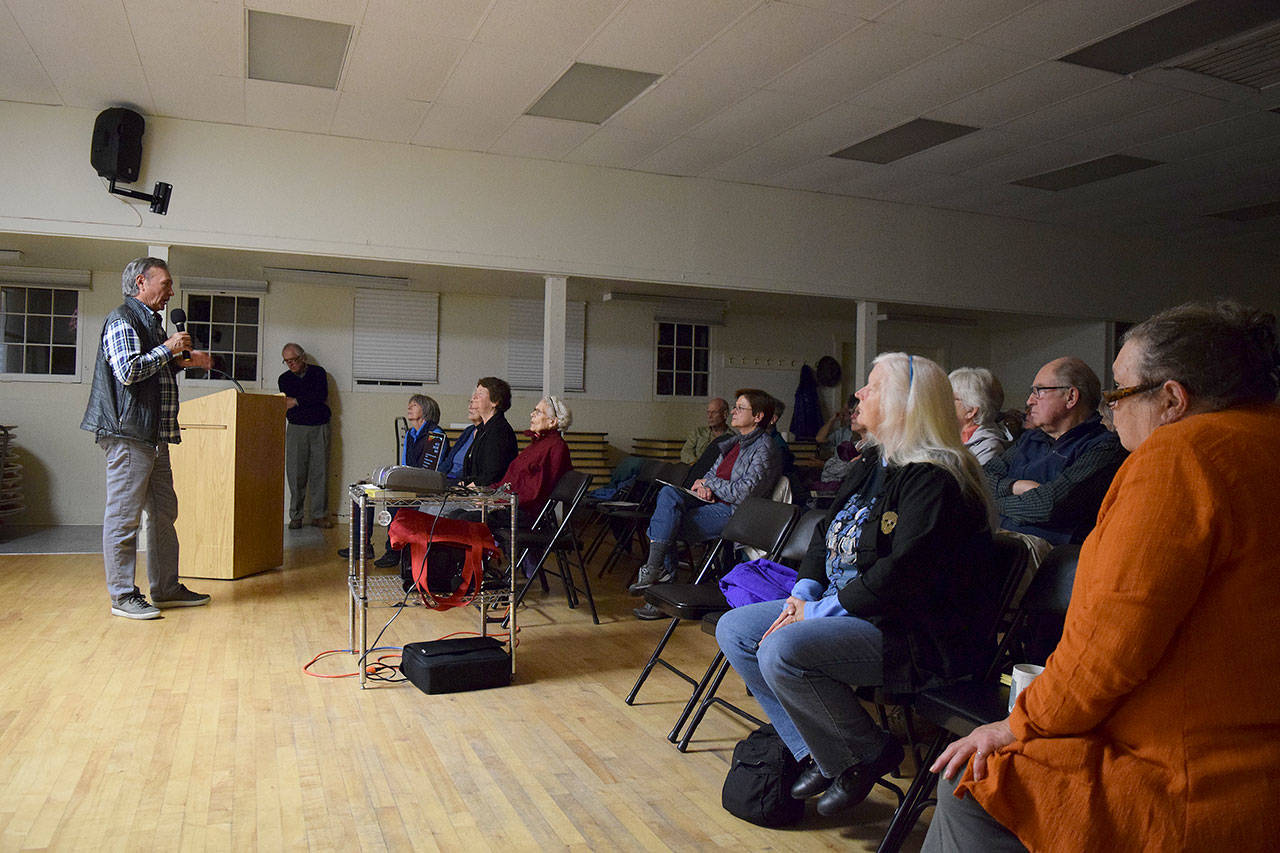Light-emitting diodes (LEDs) save energy and money, but there’s a hidden price tag.
According to a group of “Dark Sky” advocates, they interrupt the circadian rhythm of wildlife, one’s ability to see the stars and even human health. Thus, they’re hoping to dim night lights across the island. The ultimate goal: convince policy makers to establish designated dark sky zones in cities and rural areas of the county.
“Many people move here or visit for the natural beauty, and it should be as beautiful in the night as in the day,” Useless Bay resident Joe Quintana said. “My wife and I have been researching this for years, have developed a slide show and started presenting to various organizations trying to get Langley to become an international dark sky city. We hope we can move on and get the whole island on board.”
Quintana presented the information to Whidbey Audubon Society and a few members of Island County Astronomical Society Thursday night. In his presentation, Quintana explained why the island should minimize the light pollution it produces and the negative effects it has on local wildlife. After focusing on the impact light pollution has on birds, Quintana discussed what can be done.
Quintana and his wife Joann Quintana are members of International Dark Sky Association. They’ve garnered support from members of Whidbey Audubon Society, although the organization as a whole hasn’t penned support.
According to Quintana, light pollution can have “devastating” and disrupting effects on migration patterns for many animals, particularly for birds. Birds become confused by the “constant state of twilight,” and often circle bright lights to the point of exhaustion. This happens more often with light in the high-intensity white to violet spectrum, which LED lights fall under. Older sodium lights, typically used for street lamps, are in the lower-intensity yellow and red spectrum.
According to Jay Adams, Whidbey Audubon immediate past president and dark sky advocate, bright artificial lighting can also make birds late to breeding grounds, increases predation and can alter egg laying and molting timetables. But, it’s not only birds that are thrown off by bright night skies. Adams says salmon change their migration patterns in night light and pollinators decrease activity as “nocturnal visits to artificially-lighted plants is reduced by 62 percent.” Human health is also impacted, as overexposure to high kelvin lights has been linked to degenerating vision and certain forms of cancer, although researchers aren’t sure why regarding the latter.
Basically, throwing off wildlife’s circadian rhythm can have a huge impact, they say.
However, they recognize the solution isn’t to go completely dark at night or to revert back to an incandescent world. As LEDs save energy, it’s more a matter of dimming the lights.
“What I want to stress is nobody is saying to turn off the lights,” Quintana said. “It has done wonderful things for progress, but humans tend to overdo things. The issue is how bright these lights are and where they give off light.”
A solution pitched by Adams and Quintana is to lower the Kelvin level of lights used at home and in towns. Light is measured on the Kelvin scale, which spans the ROYGBIV color spectrum. Reds and yellows are lower on the scale with numbers around 2,500 Kelvin, whereas blues and violets are at the top with numbers ranging from 4,000 to 8,000 Kelvin. The blueish white light emitted from LEDs are typically 4,000 or above, but 3,000 kelvin LED bulbs are available. The older sodium lights are typically below 3,000, but are less energy efficient.
Other solutions include decreasing the wattage of lights used and shielding lights so they illuminate the ground rather than the night sky. However, Adams notes this would still have negative impacts on humans and wildlife on the ground. The ultimate goal, he says, is to use as little light as possible.
Coincidentally, the City of Langley is deciding what kind of streetlights to use, and is testing a 45 watt, 3,000 Kelvin streetlight on Third Street and Park Avenue. Last summer, residents complained about a 4,000 Kelvin test light at the same location. Dark sky advocates have been in contact with the city, and a statement of support is included in Langley’s draft comprehensive plan, Quintana says.
Mayor Tim Callison said the city hasn’t yet decided to draft an ordinance to dim the lights.
“It’s something that’s being considered, but we are an urban area and there are some needs for safety,” Mayor Tim Callison said. “It’s a balance between the safety of our citizens but understanding people’s desire to limit light emissions. I’d have to say, in general, the city council endorses the concept and will try to accommodate those wishes.”
Quintana admits “the science is early on this,” as blue light-emitting LEDs were invented in the early 1990s. However, he says it’s caught the attention of many scientists, who’ve noted the sharp increase in light pollution since the advent of LEDs. Quintana believes the high wattage and kelvin level of LEDs is something energy companies and the transportation departments, who install street lights, can fix.



